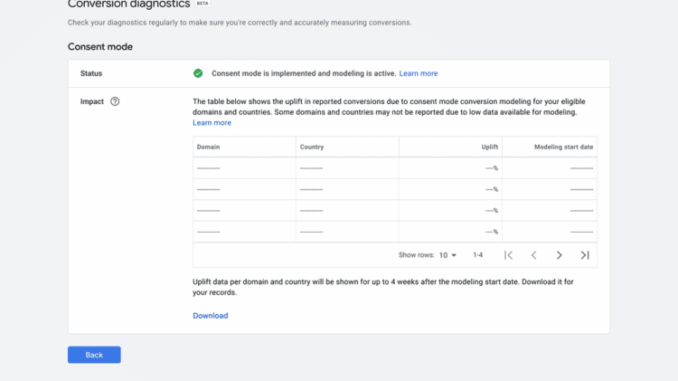
Google is rolling out new features to give advertisers additional help with setting up and troubleshooting Consent Mode. A new certified partner program is also available with additional support with implementation and tech challenges.
About Consent Mode. Consent Mode allows advertisers to adjust how your Google tags behave based on the consent status of your users. It also enables Google to model for gaps in conversions. The Google tags will dynamically adapt, utilizing cookies for specified purposes when consent has been given by the user. using the consent signals, Google will apply conversion modeling to recover lost conversions due to consent changes.
Consent Mode status and diagnostics. Google has built new support and features to help advertisers set up Consent Mode correctly. The Google Tag Assistant troubleshooting guide covers possible cases and solutions if Consent Mode is not detected or consent is lower than expected.
Diagnostics can be directly accessed on the conversion summary or action settings page.
What Google says. “In coming months, you’ll be able to view troubleshooting alerts in your diagnostics tabs and see domain-level insights about your tagging and consent rate. You’ll also be able to download a list of URLs and access Google Tag Assistant’s consent debugging tools to help you fix issues with your setup.
Soon, we’ll be surfacing troubleshooting recommendations in the diagnostics tab. In the meantime, you can access the recommendations tab to ensure Consent Mode is properly set up and that you’re receiving the full benefits of conversion modeling” says Shirin Eghtesadi, Senior Product Manager, Privacy Centric Measurement, in the Google announcement today.
Activating Consent Mode. Advertisers can review eligibility requirements here. Google has also partnered with Consent Management Platforms (CMP) and is launching a new partner management platform with partners such as One Trust, Osano, Cookiebot, and more.
It should also be noted that in order to meet the thresholds, advertisers will need to have a presence in the European Economic Area (EEA) or the UK.
Get the daily newsletter search marketers rely on.
<input type=”hidden” name=”utmMedium” value=”” />
<input type=”hidden” name=”utmCampaign” value=”” />
<input type=”hidden” name=”utmSource” value=”” />
<input type=”hidden” name=”utmContent” value=”” />
<input type=”hidden” name=”pageLink” value=”” />
<input type=”hidden” name=”ipAddress” value=”” />
Processing…Please wait.
SUBSCRIBE
See terms.
function getCookie(cname) {
let name = cname + “=”;
let decodedCookie = decodeURIComponent(document.cookie);
let ca = decodedCookie.split(‘;’);
for(let i = 0; i <ca.length; i++) {
let c = ca[i];
while (c.charAt(0) == ‘ ‘) {
c = c.substring(1);
}
if (c.indexOf(name) == 0) {
return c.substring(name.length, c.length);
}
}
return “”;
}
document.getElementById(‘munchkinCookieInline’).value = getCookie(‘_mkto_trk’);
CMP partners. CMP partners are integrated with Consent Mode and Google Tag Manager, which help ensure proper implementation and address any technical issues. CMPs help manage cookie consent banners and direct the consent management process which begins when a user lands on your website and makes a consent choice on a CMP banner. The CMP then communicates that choice to the Google tag via Consent Mode, and the tag adjusts its behavior accordingly.
Why we care. Most of us are fully aware that new regulations concerning privacy are at the forefront of our jobs as advertisers. Consent Mode ensures that websites protect the confidentiality and security of user data, while still allowing for accurate conversion and targeting data.
If you meet the requirements, check into partnering with a CMP to implement Consent Mode.
The post Google launched additional support and troubleshooting for Consent Mode appeared first on Search Engine Land.
Source: Search Engine Land
Link: Google launched additional support and troubleshooting for Consent Mode


